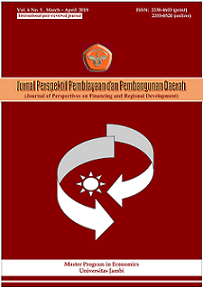An economic analysis of women’s employment and divorce
DOI:
https://doi.org/10.22437/ppd.v6i5.6446Abstract
Divorce is a condition that might bring economic and social problems. This study examined economic factors that affect probability of divorce on working women in West Sumatera based on Becker’s theory of divorce. Variables tested in this study are income, working hours, number of children, education, sector of work and employment status of ever married working women aged 15 and over, with marital status married and divorce based on National Economy and Sosial Survey 2016. Logistic regression analyses used to obtain likelihood estimate for probability of marital dissolution of employed women. The result of the study revealed that those factors include income, working hours, number of children, education, place of work and employment status, significantly affect the probability of divorce. Education has the maximum likelihood among other factors. The working women with low education have highest risk of divorce followed by those who work more than 40 hours per week, low income (poor), having no children or children less than 2, work in non agriculture and employment status as an employee.
Downloads
References
Becker, G. S. (1981). A Treatise on the Family. Cambridge: Harvard University Press.
Becker, G. S., Landes, E. M., & Michael, R. T. (1977). An Economic Analysis of Marital Instability. Journal of Political Economy, 85(6), 1141-1187.
Central Bureau of Statistics. (2017). Labor Force Situation in Sumatera Barat Province August 2016. Padang: BPS - Statistics of Sumatera Barat Province.
Central Bureau of Statistics. (2017). Sumatera Barat Province in Figures. Padang: BPS - Statistics of Sumatera Barat Province.
Elfindri, & Bachtiar, N. (2004). Ekonomi Ketenagakerjaan. Padang: Andalas University Press.
Fukuyama, F. (2000). The Great Disruption. London: Profile Books.
Greenstein, T. N. (1990). Marital Disruption and the Employment of Married Women. Journal of Marriage and Family, 52(3), 657-676.
Guest, P. (1992). Marital Dissolution and Development in Indonesia. Journal of Comparative Family Studies, 23(1), 95-113.
Hirschman, C., & Teerawichitchainan, B. (2003). Cultural and Socioeconomic Influences on Divorce during Modernization: Southeast Asia 1940s to 1960s. Population and Development Review, 29(2), 215-253.
Hoffman, S. D., & Duncan, G. (1988). What are the Economic Consequences of Divorce. Journal of Demography, 25(4), 641-645
Jaloovara. (2003). Socioeconomic Status and Divorce in First Marriages in Finland. Population Studies, 55, 119-133.
Kalmijn, M., & Poortman, A.-R. (2006). His or Her Divorce? The Gendered Nature of Divorce and Its Determinants. European Sociological Review, 22(2), 201-214.
Khumas, A. (2015). Model Penjelasan Intensi Cerai Perempuan Muslim di Sulawesi Selatan. Jurnal Psikologi, 42(3), 189-206.
Lee, Y.-J. (2006). Risk Factors in the Rapidly Rising Incidence of divorce in Korea. Asian Population Studies, 2(2), 113-131.
Nurhasanah, & Rozalinda. (2014). Persepsi Perempuan Terhadap Perceraian: Studi Analisis Terhadap Meningkatnya Angka Gugat Cerai di Pengadilan Agama Padang. Jurnal Ilmiah Kajian Gender, 4(2), 181-201.
Poortman, A., & Kalmijn, M. (2002). Women's Labour Market Position and Divorce in the Netherlands: Evaluating Economic Interpretations of the Work Effect. European Journal of Population, 18, 175-202.
Raymo, J. M., Fukuda, S., & Iwasawa, M. (2013). Educational Differences in Divorce in Japan. Demographic Research, 28(6), 177-206.
Research Development and Education Agency of Religion Ministry of Indonesia. (2016). Ketika Perempuan Bersikap: Tren Cerai Gugat Masyarakat Muslim. (Kustini, & I. Rosidah, eds.) Jakarta: Puslitbang Kehidupan Keagamaan.
Schoen, R., Astone, N. M., Rothert, K., Standish, N. J., & Young J. (2002). Women's Employment, Marital Happines, and Divorce. Social Forces, 81(2), 643-662.
Teachman, J. (2010). Wives' Economic Resources and Risk of Divorce. Journal of Family Issues, 31(10), 1305-1323.
Tzeng, J. M., & Mare, R. D. (1995). Labor Market and Socioeconomic Effects on Marital Stability. Social Science Research, 24(4), 329-351.
Downloads
Published
How to Cite
Issue
Section
License
Copyright (c) 2019 Willi Ascandra, Nasri Bachtiar, Muhammad Nazer

This work is licensed under a Creative Commons Attribution 4.0 International License.

















